NRS priority species
While there have been a few peaks and troughs in the annual submissions since the Nest Record Scheme (NRS) started in 1939, the general trend has been for the number of nests monitored to rise decade by decade. Current totals stand at around 40,000 nests per annum, an amazing achievement by a volunteer base that currently numbers around 600 individual surveyors and recording groups. While this indicates that the NRS is in very good health, some species are receiving more attention than others and we are increasingly being asked by recorders to provide feedback about which species are seen as the highest priority for data collection. Every nest is important – the large datasets held for common species such as Blue Tit allow detailed analysis of impacts of climate change and urbanisation, so more submissions are always very useful. The aim of this page is to highlight those species for which annual totals across the UK are low and/or declining most rapidly.
UK passerine priorities
Open-nesting passerines are the group of species that we have highlighted as being the highest priority for NRS over the last decade. The number of records received for this group of c. 60 species had been decreasing rapidly since the 1970s, a particularly worrying statistic given that this group contains many of those species currently exhibiting the most severe population declines. Nest recorders' response to our appeals has been fantastic and the number of volunteers monitoring target species such as Linnet and Willow Warbler has increased significantly over the past few years.
The number of observers collecting Willow Warbler nest records (left) and Linnet nest records (right) has been on the up since the mid-2000s
This is a great start and we look forward to even more recorders submitting nest records for these and other passerine priority species, some examples of which are below.
|
Record submissions peaked in the mid-1980s at just under 300 nests per year, but have since fallen to below 100. Grey Wagtail populations have declined by >25% since the mid-1970s, a similar trend to that displayed by Pied Wagtail. The species is on the Birds of Conservation Concern (BoCC) Amber List.
|
|
|
Record submissions peaked in the mid-1980s at just under 400 nests per year, but have since fallen to below 100. Last year’s total (219) was substantially higher and we hope that this trend will continue. Meadow Pipit numbers have fallen steadily since the 1970s, with declines steepest in Scotland. The species is on the BoCC Amber List.
|
|
|
Record submissions peaked in the late 1960s and early 1970s at over 1,000 nests per year but have since fallen to around 300. Dunnock populations declined steeply in the 1970s, but there are some signs of population recovery over the last decade. The species is on the BoCC Amber List.
|
|
|
Record submissions peaked in the late 1960s at over 500 nests per year but have since fallen to below 100. Greenfinch populations have fluctuated over the last five decades but have exhibited a steep decline in recent years due to the trichomonosis outbreak. The species is on the BoCC Green List.
|
|
|
Record submissions peaked in the mid-1970s at over 350 nests per year but have since fallen to below 100. Reed Bunting populations declined significantly during the late 1970s, appearing to stabilise at a lower level in the early 1980s. The species is on the BoCC Amber List.
|
UK non-passerine priorities
Non-passerine groups include seabirds, waterbirds, raptors, waders and owls. Numbers of records received for all seabird and wader species are low and/or aggregated and more submissions of any species would greatly increase our ability to accurately assess breeding success. Submissions for box-nesting raptors and owls (e.g. Barn Owl) are higher but more data on Kestrel and open-nesting species would also be very valuable. The following are examples of species for which submissions have declined significantly.
|
Record submissions peaked in the late 1990s at just under 650 nests per year, but have since fallen to almost zero. The species has declined steadily over the last two decades, although numbers are still much higher than they were in the 1960s. The species is on the BoCC Amber List.
|
|
|
Record submissions peaked during the end of the 1990s at just under 700 nests per year, but have since fallen to below 100. Grey Heron numbers have increased moderately across the UK, more so in England and Wales than in Scotland, since the 1930s. The species is on the BoCC Green List.
|
|
|
Record submissions peaked in the early 1990s at just over 350 nests per year but have since fallen to below 100. Sparrowhawk populations have increased rapidly in England during the 1970s and 1980s, but have levelled off over the last two decades. The species is on the BoCC Green List.
|
|
|
Record submissions peaked in the late 1990s at over 1,350 nests per year but have since fallen sharply to around 300. UK Lapwing populations have declined rapidly since the 1980s, with numbers falling by over 50%. The species is on the BoCC Red List.
|
|
|
Record submissions prose steadily between the 1940s and the late 1990s, peaking at over 120 per year and then slumping suddenly to fewer than 30. Curlew populations have declined moderately across England and Wales since the mid-1970s. The species is on the BoCC Amber List.
|

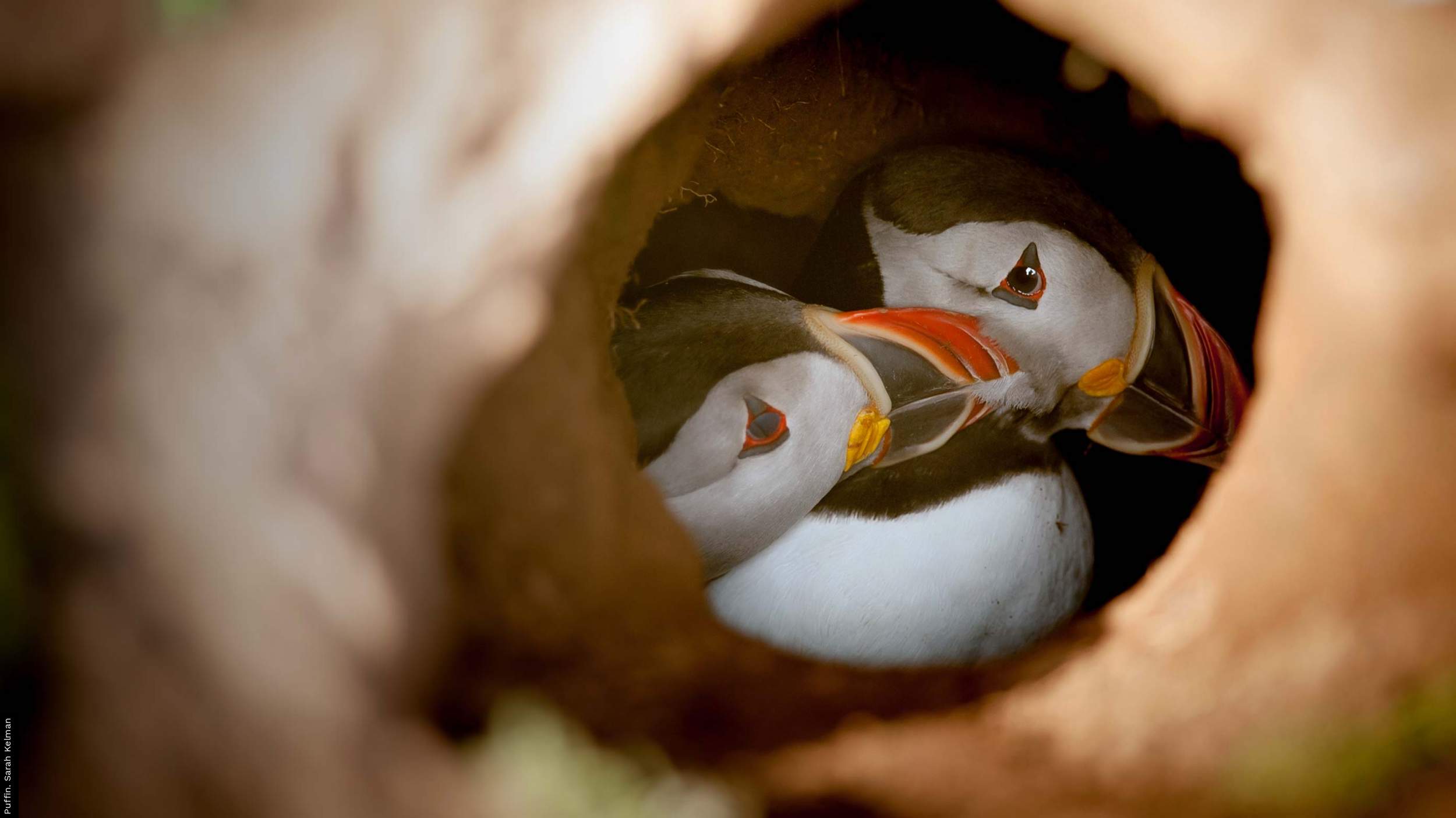

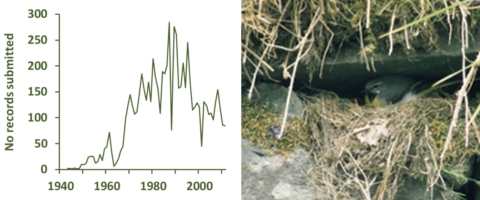
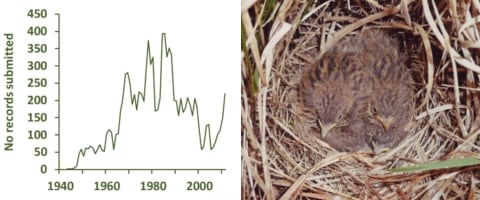
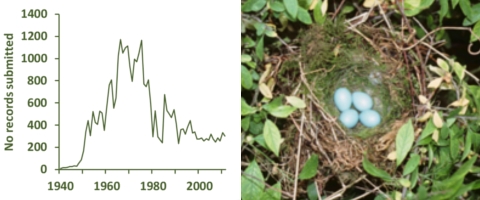
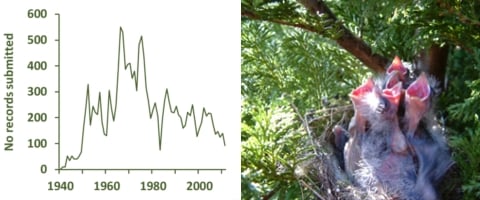
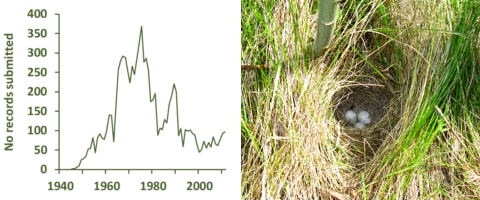
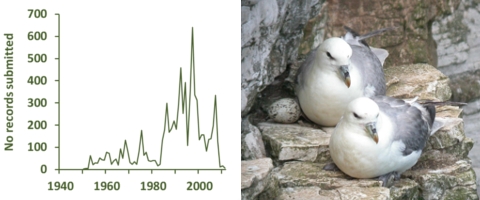
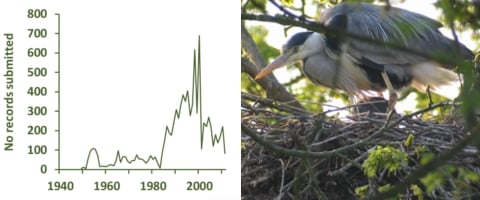
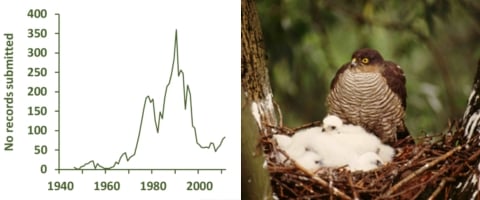
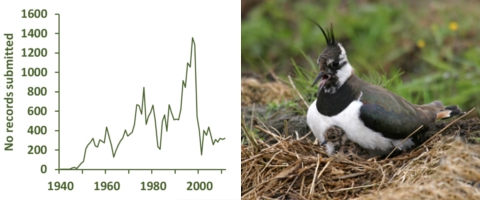
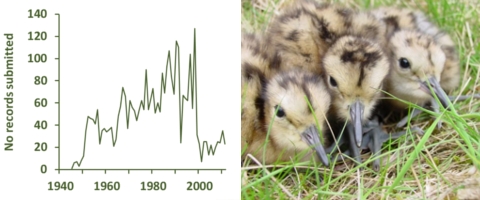




Share this page